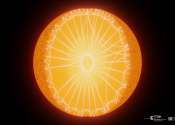Chinese astronomers detect rubidium and samarium in the atmosphere of a distant exoplanet
Using the Echelle SPectrograph for Rocky Exoplanets and Stable Spectroscopic Observations (ESPRESSO), astronomers from the Chinese Academy of Sciences (CAS) have investigated the atmosphere of MASCARA-4b—a distant "ultra-hot ...









